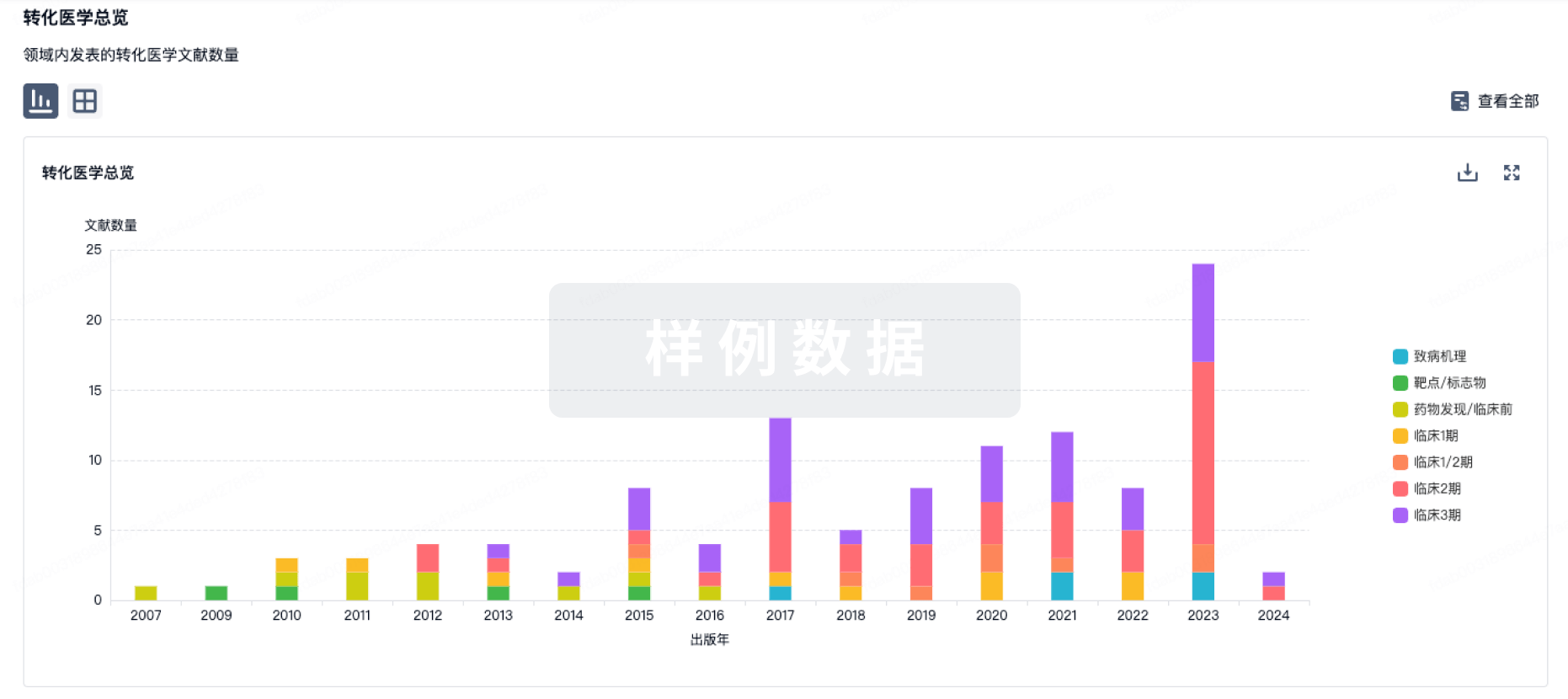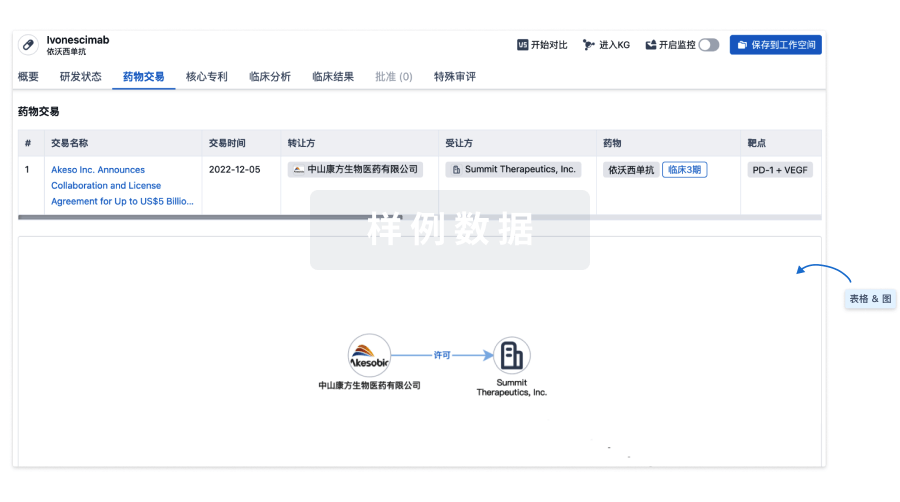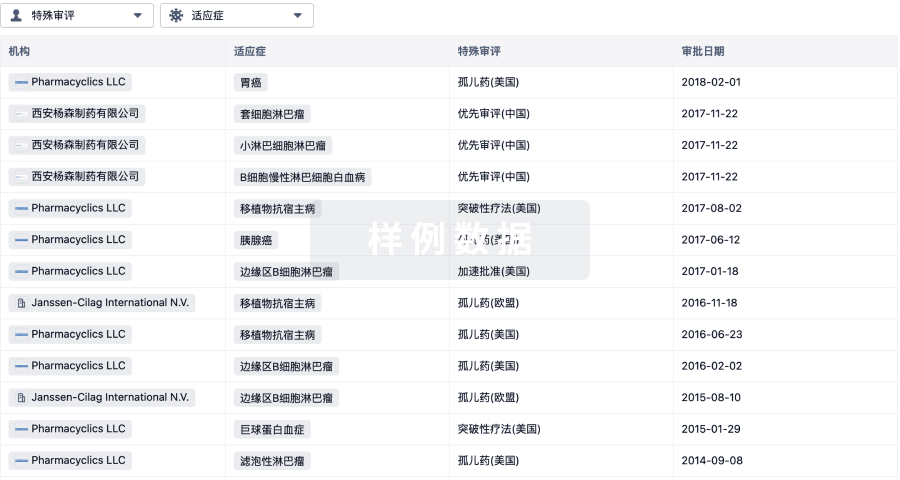预约演示
更新于:2025-09-19
Oleanolic Acid
齐墩果酸
更新于:2025-09-19
概要
基本信息
原研机构- |
非在研机构- |
权益机构- |
最高研发阶段批准上市 |
首次获批日期 中国 (1983-01-01), |
最高研发阶段(中国)批准上市 |
特殊审评- |
登录后查看时间轴
结构/序列
分子式C30H48O3 |
InChIKeyMIJYXULNPSFWEK-GTOFXWBISA-N |
CAS号508-02-1 |
关联
2
项与 齐墩果酸 相关的临床试验ChiCTR1900021568
Clinical Efficacy of Oleanolic Acid Tablets in Patients with Nonalcoholic Fatty Liver Disease: A randomized controlled trial
开始日期2019-01-01 |
申办/合作机构  常州市第二人民医院 常州市第二人民医院 [+2] |
ISRCTN03372660
Effect of olive oil enriched in oleanolic acid on the incidence of type 2 diabetes mellitus in patients with pre-diabetes: a multicentre randomised double-blind controlled trial
开始日期2009-05-20 |
申办/合作机构- |
100 项与 齐墩果酸 相关的临床结果
登录后查看更多信息
100 项与 齐墩果酸 相关的转化医学
登录后查看更多信息
100 项与 齐墩果酸 相关的专利(医药)
登录后查看更多信息
6,348
项与 齐墩果酸 相关的文献(医药)2025-12-31·PHARMACEUTICAL BIOLOGY
A triterpene-enriched natural extract from
Eucalyptus tereticornis
modulates the expression of genes involved in adipogenesis, lipolysis, and extracellular matrix remodeling in a primary human and mouse cell line adipocyte
Article
作者: Fernandez, Geysson Javier ; Mejia-Garcia, Alejandro ; Balcazar, Norman ; Acin, Sergio
CONTEXT:
Obesity induces alterations in adipocyte size, tissue inflammation, vascularization, and extracellular matrix composition. Previous studies have shown that a leaf extract of Eucalyptus tereticornis Sm. (Myrtaceae), with ursolic acid, oleanolic acid, and ursolic acid lactone mixed with minor metabolites, provided a superior antiobesity effect than reconstituted triterpenoid mixtures in adipocyte cell lines and a pre-diabetic mouse model. Further identification of the molecular mechanisms of action of this mixture of triterpenes is required.
OBJECTIVE:
This study analyzes the effect of the natural extract and its components on early RNA expression profiles in human primary cultured adipocytes and a mouse cell line.
MATERIALS AND METHODS:
RNA was sequenced using the DNBseq platform and the EnrichR software to perform gene enrichment analysis using the Gene Ontology database, Kyoto Encyclopedia of Genes and Genomes, and Reactome. To conduct clustering analysis, the normalized counts of each gene and applied k-means clustering were standardized.
RESULTS:
The combination of molecules in the natural extract has an additive or synergic effect that increases the number of genes regulated associated with the biological functionality of differentiating adipocytes, with UAL playing a central role. The natural extract modulates PPAR, Wnt, and Extracellular Matrix organization pathways significantly in both cellular models. Remarkably, the extract downregulates the expression of genes involved in lipid metabolism, adipogenesis, and adipocyte fat load, such as PRKAR2B, LPIN1, FABP4, Scd1, MC5R, CD36, PEG10, and HMGCS1.
DISCUSSION AND CONCLUSIONS:
Our study shows that Eucalyptus tereticornis extract is a promising option for treating adipocyte tissue dysfunction derived from obesity.
2025-11-01·MICROBIOLOGICAL RESEARCH
Transcriptome analysis reveals biocontrol mechanisms of Acremonium sclerotigenum against Podosphaera xanthii in cucumber
Article
作者: Sossah, Frederick ; Liu, Shu-Yan ; Zhu, Yan ; Musazade, Elshan ; Aroge, Temitope
Cucumber (Cucumis sativus) is an economically important crop, but its production is severely threatened by Podosphaera xanthii, the causal agent of powdery mildew, significantly reduces yield and quality. This study evaluates the potential of Acremonium sclerotigenum as a biocontrol agent against P. xanthii in cucumber. A combination of in vitro assays and greenhouse experiments assessed its antifungal activity, disease control efficacy, and effects on plant growth. Transcriptome analysis and RT-qPCR were performed to identify and validate differentially expressed genes associated with biocontrol mechanisms and plant stress responses. A. sclerotigenum reduced P. xanthii incidence by up to 70 %, and enhanced cucumber growth, increasing leaf number by 25 %, plant height by 30 %, and chlorophyll content by 20 %. UHPLC-MS/MS confirmed the production of diverse secondary metabolites, including antimicrobial compounds such as oleanolic acid, virginiamycin, bialaphos, and sphinganine. Transcriptome profiling revealed significant upregulation of defense-related genes, including ERF1, REM, MYB10, PR-4, and RBOHA, which RT-qPCR further validated. These findings highlight the potential of A. sclerotigenum as an effective and sustainable alternative to chemical fungicides for managing powdery mildew while simultaneously promoting plant growth. This study provides valuable insights into the mechanisms underlying its biocontrol activity and supports its application as a promising tool for enhancing crop resilience and sustainable agriculture.
2025-11-01·SEPARATION AND PURIFICATION TECHNOLOGY
An integrated method for efficient isolation and structural elucidation of two homologous polysaccharides from medicinal loquat leaves
作者: Liu, Yaqin ; Zhao, Xiaoyong ; Wu, Congyu ; Liu, Yilong ; Pan, Yuanjiang ; Pan, Yining ; Li, Xian ; Chen, Junwei ; Li, Xiaoying
A novel ionic liquid/inorganic salt system, [C14mim][PF6]/Na2CO3, was developed for the simultaneous extraction and purification of polysaccharides from medicinal loquat leaves in a single-step procedure.The system forms a homogeneous phase upon heating in water for the polysaccharide extraction and transitions to a solid-liquid two-phase system upon cooling centrifugation for the polysaccharide separation, enabling polysaccharides to partition into the supernatant while proteins and other impurities gather in the sediment.This innovative approach demonstrated superior deproteinization efficiency, achieving a protein removal rate exceeding 99%, significantly outperforming the traditional Sevag method.Crude polysaccharides were further separated into alkali-extracted and water-soluble fractions, followed by purification using DEAE cellulose and Sephadex G-100 chromatog., yielding two homologous polysaccharides, EJp1-1 and EJp2-1.Based on the complementary information, mainly the NMR data, of these two homologous polysaccharides, a new strategy for rapid structure anal. was established.Both EJp1-1 and EJp2-1 were rhamnogalacturonan-I (RG-I) type pectins.EJp1-1 was primarily composed of the RG-I backbone, while EJp2-1 was dominated by the side chains.The side chains of EJp1-1 and EJp2-1 consisted primarily of α-1,5-linked arabinan and β-1,4-linked galactan, which were alternately attached to the O-4-position of rhamnose residues of the repeat RG unit of the main chain.To sum up, this work integrates the efficient extraction, purification and rapid structure anal. of homologous polysaccharides, potentially promoting the sustainable utilization of plant-derived resources.
16
项与 齐墩果酸 相关的新闻(医药)2025-09-19
近日,全球首个用于治疗6月龄及以上患者大疱性表皮松解症(Epidermolysis Bullosa,EB)相关伤口的创新药物Filsuvez™(桦醇三萜凝胶)在乐城先行区获批,可治疗营养不良型(Dystrophic EB,DEB)和交界型(Junctional EB, JEB)两种亚型。
在海南省药品监督管理局、海南省卫生健康委员会、海口海关、乐城管理局、乐城医疗药品监督管理局等多部门协作支持下,Filsuvez™落地博鳌未来医院(海南省妇女儿童医学中心国际合作部暨乐城分院),接轨国际先进治疗方案,有望改善国内“蝴蝶宝贝”生存质量,为患儿及其家庭重燃生活的光亮。
大疱性表皮松解症(EB)是一组罕见且极其痛苦的遗传性皮肤病[1]。患者因基因突变导致皮肤和黏膜异常脆弱,轻微摩擦或碰撞就会出现水疱、血疱和糜烂[2],伴有剧烈疼痛[3],患者的皮肤和黏膜如脆弱的蝴蝶翅膀,因此他们被称为“蝴蝶宝贝”。
根据症状严重程度不同,EB可分为单纯型(EBS)、Kindler型(KEB)、交界型(JEB)和营养不良型(DEB)四大类,其中交界型和营养不良型患者病情更为严重,可能出现肢体畸形、生长发育迟滞、吞咽困难等多系统受累表现,严重时可危及生命。
作为国家公布的第一批罕见病目录收录病种[4],国内EB患者数推算约为1.5万例[5],治疗现状不容乐观,“无药可用”是他们长期面临的难题。《2019版中国罕见病诊疗指南》明确指出,国内尚无获批用于EB治疗的药物,临床仅能通过“防止机械性损伤和感染”进行对症支持治疗[6],无法解决“创面长期不愈、换药频繁且疼痛剧烈”等核心问题。《2019年遗传性大疱性表皮松解症患者调研报告》显示, EB患者不仅自身承受着沉重的身心健康负担,其家庭也面临着巨大的照护负担和经济负担[7]。
当前EB治疗的核心未满足需求,在于缺乏促进创面愈合、减轻疼痛等疾病负担与照护负担的治疗药物。Filsuvez™正是填补这一缺口的创新解决方案。
Filsuvez™是桦醇三萜凝胶,包括白桦脂醇、白桦脂酸、羽扇豆醇、赤藓二醇和齐墩果酸[8]。迄今为止针对EB开展的规模最大的全球、多中心、随机对照III期临床试验EASE研究结果显示,桦醇三萜凝胶治疗后可提高患者目标创面愈合率、缩短创面愈合时间、早期持续降低创面面积、降低创面换药频率、降低换药中患者操作性疼痛、减少患者及照护者伤口护理时间、降低EB相关伤口护理费用。作为首个获批用于治疗DEB和JEB的药物,Filsuvez™获欧盟欧洲药品管理局(EMA)及美国食品药品监督管理局(FDA)孤儿药认定,并于2022年6月及2023年12月先后获欧盟EMA和美国FDA批准上市。
此次获批落地乐城先行区的Filsuvez™来自拥有九十年历史的意大利凯西集团。Filsuvez™落地乐城先行区,不仅让国内EB患者实现“不出国门用全球新药”,也再次证明“先行先试”政策对罕见病患者的重要意义。通过“先行先试”,乐城正不断加快创新药械在国内的可及性,为罕见病患者点亮“生命之光”。同时,也将为更多罕见病创新药械的国内可及提供范本,推动我国罕见病诊疗水平向国际接轨。
据悉,除Filsuvez™外,凯西集团仍有多款罕见病产品尚未引入中国,这些产品的适应症涵盖皮肤、内分泌代谢、眼科、血液及免疫系统等多个疾病领域。凯西未来也将通过先行先试及加速注册等多种路径加快引进这些创新产品,满足国内罕见病患者临床用药需求。
指导团队:
复旦大学附属儿科医院皮肤科 李明教授团队
海南省妇女儿童医学中心 黄晓燕教授团队
目前Filsuvez™可在博鳌未来医院(海南省妇女儿童医学中心国际合作部暨乐城分院)申请使用。
联系方式:
博鳌未来医院机构办 王瑜
电话:0898-36860145
15203612191(微信)
参考文献:
[1] 蝴蝶宝贝关爱中心中文网站(https://www.debra.org.uk/zh-CN/get-support/eb-support-and-resources/epidermolysis-bullosa-eb/)
[2] 大疱性表皮松解症的症状、类型和原因|NIAMS公司(https://www-niams-nih-gov.libproxy1.nus.edu.sg/health-topics/epidermolysis-bullosa)
[3] 凯西官网新闻发布(https://www.chiesi.com/en/global-rare-diseases-fda-approval-filsuvez-epidermolysis-bullosa/)
[4] 关于公布第一批罕见病目录的通知_国务院部门文件_中国政府网(https://www.gov.cn/zhengce/zhengceku/2018-12/31/content_5435167.htm)
[5] 蝴蝶宝贝关爱中心(https://www.debra.org.cn/)
[6] 《2019版中国罕见病诊疗指南》(202412121013216793.pdf)
[7] 《2019年遗传性大疱性表皮松解症患者调研报告》(EB-survey-2019-dongdong-detail.pdf)
[8] Filsuvez|欧洲药品管理局(EMA)(https://www.ema.europa.eu/en/medicines/human/EPAR/filsuvez)
“乐”享世界医疗,“城”就健康梦想
更多相关信息
请关注“乐城发布”公众号
咨询电话:4000-118-118
审核:何颖
编辑:袁昌佑
孤儿药临床3期临床成功
2025-09-04
·药思享
青A(原杰青)获得者
北京大学药学院 王晶
王晶,理学博士,研究员(PI),博士生导师,化学生物学系副主任。2009年博士毕业于中国科学院上海有机化学研究所。随后进入美国芝加哥大学化学系/霍华德休斯医学院(HHMI)从事博士后研究;2016年加入北京大学药学院化学生物学系和天然药物及仿生药物国家重点实验室PI并入选中组部海外高层次青年人才项目,兼聘北京大学国家生物医学成像科学中心PI。目前担任中国药理学会分析药理学专业委员会委员和青年委员会常委。获得北京大学拜耳研究员奖、医学部青年科技奖等奖励。课题组聚焦开发高特异性、高灵敏度和高时空分辨率的化学生物学技术(化学标记、组学、探针和成像技术)实现细胞信号分子动态的精准检测和分子机制研究。
主要研究领域
1. 开发信号转导小分子的分子探针以及通过蛋白组学,高通量测序等技术研究其调控机制。
2. 针对肿瘤内源性代谢分子的荧光蛋白探针(Biosensor)和超分辨显微成像。
3. 新型抗肿瘤靶标和先导化合物的发现与确证。
浙江大学附属第二医院药学部 胡薇薇
2002年本科毕业于浙江大学医学院临床医学专业,2007年博士毕业于浙江大学医学院药理学专业并留校工作。曾前往日本北海道大学、美国克利夫兰临床医学中心神经科学所进修。主要从事组胺受体在神经精神疾病中的作用及精准药物靶点发现和新药研究,以及小胶质细胞的新功能研究。在PNAS、J Exp Med、Nat Commun、Pharmacol Therapeut、Autophagy、Cell Rep等国际知名期刊发表SCI论文70余篇。先后承担了国家自然科学基金6项(包括国家优秀青年科学基金项目)、国家重点研发计划(课题负责人)、浙江省自然科学基金杰出青年基金和面上项目各1项,并获得首批浙江大学求是青年学者称号(2011),中国药理学会-施维雅青年药理学工作者奖(2013)、浙江省医坛新秀称号(2015)、浙江省“万人计划”青年拔尖人才(2018)、省有突出贡献青年人才(2019)。此外,还作为主要成员先后获得教育部自然科学奖一等奖、省自然科学一等奖、省科技进步奖一等奖,获得国家发明专利2项。目前担任中国药理学会神经精神药理学专业委员会委员、生化与分子药理学专业委员会委员、浙江省药理学会副理事长等。
青B(原优青)获得者
深圳理工大学药学院 殷勤
殷勤,深圳理工大学药学院 长聘副教授、博导,中国科学院深圳先进技术研究院医药所 研究员(兼职)。2025年国自然青B(原优青)获得者,广东省自然科学“杰出青年基金”获得者。荣获2025年ChemComm Emerging Investigator;2023年Thieme Chemistry Journals Award以及2021年度深圳市自然科学一等奖。
2009年本科毕业于湖南师范大学(导师:李金恒),2014年于中科院上海有机化学研究所获得理学博士学位(导师:游书力 研究员)。2014-2017年,在德国“洪堡奖学金”支持下,于柏林工业大学进行博士后研究 (导师:Martin Oestreich)。2017年6月-2021年6月,加入南方科技大学前沿与交叉科学研究院 任职副研究员(合作者:张绪穆 教授)。2021年7月加入深圳理工大学药学院/中国科学院深圳先进技术研究院医药所,任职独立PI,课题组长。2025年7月晋升为长聘副教授。
目前研究方向主要聚焦于有机合成化学及其在药物制备以及新药发现中的应用。迄今为止发表一作和通讯文章40余篇,包括Chem. Soc. Rev. ,JACS , Angew,ACS Catal., Chem. Sci. 等。目前主持国家自然科学基金青B、面上项目等多项基金。
温州医科大学药学院 宋林涛
校聘研究员/博导,大分子药物与规模化制备全国重点实验室主任助理。长期以“生长因子与代谢调控”为研究主线,聚焦“FGF与代谢性肝病”,从临床发现FGFs是肝脏代谢紊乱高敏性响应因子的基础之上,深入探索FGFs启动特异性信号转导,而发挥调控肝脏脂质和胆汁酸稳态的独特生物学功能和药理机制,为基于FGFs的代谢性肝病治疗靶标发现和药物研发提供了新思路和新策略。以通讯或第一(含共同)作者在Cell Metab (2025), Nat Commun (2020, 2018), Hepatology (2025, 2022, 2018), Kidney Int (2018) 等高质量SCI期刊发表研究论文11篇, 论文累计被Nature、Cell、Trends Endocrinol Metab 和Nat Rev Drug Discov 等他引770 余次;主持国家自然科学基金委面上项目、青年项目以及浙江省自然科学基金委重点项目各1项,作为核心骨干参与国家自然科学基金重点和重大项目。
中山大学药学院 黄怀义
黄怀义,中山大学药学院(深圳)副教授,广东省杰出青年基金获得者,作为项目负责人目前在研国家自然科学基金等省部级项目7项。课题组围绕肿瘤能量和物质代谢重编程的分子机制,开发了光催化肿瘤细胞还原型辅酶的新型抗肿瘤金属药物,实现扰乱肿瘤细胞的电子传递和物质合成代谢,为开发治疗乏氧和耐药性肿瘤、耐药菌的新型药物提供全新的策略。相关研究成果以通讯作者或第一作者在Nat. Chem.、Angew. Chem. Int. Ed. (7篇)、J. Med. Chem. (5篇)、Sci. China Chem. (2篇)、Coord. Chem. Rev.、Biomaterials (2篇)等国内外权威学术期刊发表SCI论文70余篇,申请光活化金属药物的中国发明专利40项,授权21项。论文总引用4300余次,ESI高被引论文4篇,12篇论文引用超过100次,单篇最高被引432次,H指数33。
中国中医科学院中药研究所 唐欢
唐欢,中国中医科学院中药研究所/青蒿素研究中心副研究员、硕士生导师,道地药材品质保障与资源持续利用全国重点实验室青年PI,中国中医科学院优秀青年科技人才支持计划银指标达标者。2012年获北京理工大学理学学士,2017年获北京大学理学博士,2018—2020年于北京大学化学与分子工程学院从事博士后研究。研究方向为中药药理学与化学生物学,聚焦中药活性成分作用机制与新型递送系统。主持国家自然科学基金青年项目等课题10余项;以第一/通讯作者在Nature Nanotechnology、Nature Protocols、Cell Chemical Biology、Chemical Science、Analytical Chemistry等中科院1区期刊发表论文20余篇(IF>10者10篇);授权发明专利5项;获中国民族医药学会科学技术奖一等奖(2023)、中国中西医结合学会科学技术奖二等奖(2024)。
中国中医科学院中药研究所 王彩霞
王彩霞,中国中医科学院中药研究所副研究员、硕士生导师,道地药材品质保障与资源持续利用全国重点实验室青年PI,中国中医科学院优秀青年科技人才支持计划银指标达标者。2009年获北京林业大学工学学士,2014年获中国科学院过程工程研究所工学博士。围绕天然产物的合成生物学开展工作,建立了基于酿酒酵母的细胞工厂智能优化体系,实现甘草酸、齐墩果酸等天然产物高产。主持国家自然科学基金及国家重点研发计划子课题等国家级项目7项;以通讯作者在 Nat. Commun、Green Energy Environ、ACS Sustainable Chem. Eng、Bioresour. Technol、J. Agric. Food Chem等国际权威期刊发表论文多篇;授权国际国内发明专利9项,技术转让及横向合作累计逾千万元;获河北省科技进步奖等2项。
不完全统计,信息来源于网络,如有侵权,请联系删除
2025-08-11
·药学进展
“
点击蓝字 关注我们
刘金春
医学硕士,南京市鼓楼医院副主任药师。担任南京医科大学 PBL( Problem-Based Learning)导师,中国药科大学外聘教师,江苏省药学会医药教育与健康促进专委会委员。
2013 年毕业于南京医科大学并获医学硕士学位,同年就职于南京市鼓楼医院药学部。主要研究方向包括: 1)药源性疾病的预警与处理; 2)新型药物靶向制剂。
先后主持省市级科研基金 3 项、校级科研基金 3 项。以第一或通信作者发表中英文学术论文 20 余篇,参编专著 1 部,申请国家发明专利 1 项,牵头多中心临床研究 1 项。
黄晓佳
药学博士,常州大学医学与健康工程学院副教授,硕士生导师。担任中国药理学会会员, Neuroscience 和 RSC Adv 等杂志审稿人。
2007 年毕业于浙江大学医学院并获药理学博士学位。主要研究方向包括: 1)呼吸系统疾病治疗药物药理学机制研究; 2)体内外药物输送系统的开发研究。
先后主持和承担了国家自然科学基金青年项目、国家博士后面上项目和省市级项目等多项,在Circulation , Sci Transl Med, Cell Rep 等刊物上发表论文 20 余篇。
长循环脂质体在肿瘤治疗领域的研究进展 PPS
张谊 1,2,王立晖 1,刘金春 2*,黄晓佳 3**
(1. 南通大学附属丹阳医院 / 江苏省丹阳市人民医院药学部,江苏 丹阳 212300;2. 南京大学医学院附属鼓楼医院药学部,江苏南京 210008;3. 常州大学生物医学工程与健康科学研究院,江苏 常州 213164)
[摘要]脂质体作为一种有效的药物输送系统,可用于包封水溶性和脂溶性药物,具有延长药物体内循环时间,提高脂溶性药物稳定性和生物利用度,降低药物毒性等优势。通过对脂质体表面进行特定修饰得到长循环脂质体,可克服传统脂质体的不足,实现体内药物长循环和细胞高摄取率。综述近年来长循环脂质体的表面修饰策略、分类及其在肿瘤治疗领域中的研究进展,旨在为其进一步的研究与应用提供参考。
脂质体是一类由磷脂通过疏水缔合作用在水中自发形成的类脂多层闭合囊泡,具有疏水层和亲水内核,粒径通常为 25 ~ 2 500 nm[1]。脂质体具有良好的生物相容性和可降解性,可将药物包封于其内部,作为一种药物递送载体,实现靶向、缓慢释放等效果 [2]。目前,药物递送脂质体已成为国内外药学领域的研究热点之一,并在临床应用方面取得了显著进展。然而,由于脂质体进入血液循环后易发生破裂,其所携带的药物易被吞噬细胞所清除,不能有效进入靶组织发挥作用 [3]。为有效解决这一难题,通过对脂质体表面进行修饰构建长循环脂质体,可减少吞噬细胞对脂质体的识别和摄取,延长其在体内的循环时间,从而提高药物的生物利用度 [4]。本文就近年来长循环脂质体常见的表面修饰策略、分类及抗肿瘤研究进展进行综述,为长循环脂质体进一步研究及应用提供参考。
1
长循环脂质体常见表面修饰策略
脂质体通过改善药物的药代动力学和药理学特性,在解决药物靶向性、缓释性、稳定性等方面起重要作用。经过表面修饰后,脂质体对亲水性药物的包封率提高,使其体内药效得以增强 [5-6]。长循环脂质体可弥补传统脂质体给药系统的不足,其经过特定表面修饰(见图 1),能在体内循环过程中保持稳定性,因而具有良好的靶向定位和缓慢释放药物的能力 [7]。
1.1 神经节苷脂和唾液酸衍生物修饰
血浆蛋白被吸附到异物表面是吞噬细胞清除所必须经历的过程,利用惰性聚合物对脂质体进行表面修饰可有效阻止脂质体被吞噬细胞吸收。脂质体表面经神经节苷脂和唾液酸衍生物 [ 如单唾液酸神经节苷脂( monosialoganglioside1, GM1) ] 进行修饰后,可具有类似于红细胞膜的特性,减少被肝脏和脾脏内吞噬系统的摄取,在血液中的停留时间延长。例如, GM1 修饰的抗肿瘤药物表柔比星脂质体在体内滞留时间明显长于未修饰的表柔比星脂质体,抗肿瘤作用也明显提高 [8-9]。 GM1 修饰的脂质体递送系统可促进巨噬细胞极化,激活宿主免疫系统,增强抗病毒能力,缓解小鼠单纯疱疹性角膜炎 [10]。GM1 能够增强脂质体膜的刚性,占据紧邻脂质体的脂周层,将其他大分子排除在外,抑制单核吞噬系统与脂质体的相互作用,延长脂质体在体内循环时间。然而, GM1 价格昂贵且不易被合成及提取,目前广泛用于脂质体表面修饰的材料为聚乙二醇( polyethylene, PEG)及其衍生物。
1.2 聚乙二醇及其衍生物修饰
PEG 及其衍生物修饰是目前最常用的脂质体表面修饰方法 [11]。 PEG 是一种无毒、无抗原性的两亲性聚合物,具有良好的水溶性和生物相容性。将PEG 修饰于普通脂质体表面,使表面亲水性基团充分暴露,与水形成水化膜,增强空间位阻,降低其被吞噬系统清除的概率,延长其在体内的循环半衰期 [12]。放射性核素成像标记实验观察显示, PEG 化脂质体的组织靶向性提高,药物的治疗效果增强,在血液中循环时间延长,肝、肾、脾等清除器官对PEG 脂质体的摄取减少 [13]。基于超临界辅助工艺制备的 PEG 化脂质体, PEG 表面产生的排斥力可阻止脂质体颗粒聚集,其在体外至少可稳定存在 70 天。与未经修饰的脂质体相比, PEG 化脂质体的药物控释时间至少延长 3 倍,且无明显的初始爆发释放,表明 PEG 化脂质体不仅提高了药物在体内的循环时间,还增强了结构的稳定性,达到了控制药物释放的目的 [14]。然而重复给药后, PEG 化纳米颗粒可被机体加速清除,即引起加速血液清除(accelerated blood clearance, ABC)效应,导致药物的安全性和有效性降低 [15]。
PEG 化脂质体可减少补体因子、调理素结合,降低被巨噬细胞识别、清除的机率。然而, PEG 修饰方法仍存在一定局限性:一方面,空间位阻可能阻碍靶细胞对脂质体的识别与摄取;另一方面,对于负载核酸、蛋白类药物的脂质体, PEG 修饰可能干扰其进入细胞核内释放,导致药物在细胞质溶酶体内被降解失效 [11]。目前已开发出多种修饰策略以替代 PEG 修饰,并赋予脂质体临床相关特性,但仍缺乏充分的相关体内药代动力学和药理学研究数据,因此 PEG 修饰仍是当前临床应用中的首选策略。
1.3 乙烯衍生物修饰
乙烯衍生物是一类被广泛应用的新型材料,其中聚乙烯醇( polyvinyl alcohol, PVA)常被用于生物医学领域,尤其是药物递送系统。 PVA 是一种热塑性非离子树脂,具有一定的表面活性、乳化能力及分散能力。在脂质体溶液中加入 PVA 和甘油等亲水试剂,脂质体的稳定性显著增强 [16]。 PVA 修饰可促进脂质体被肿瘤细胞摄取,发挥更强的体外肿瘤抑制作用 [17]。经 PVA 与壳聚糖的混合物进行表面修饰后,二氢槲皮素脂质体亲水性和缓释效果均提高;糖尿病模型小鼠实验也证明,在小鼠皮肤伤口处使用二氢槲皮素脂质体负载的纳米材料膜,可明显加速伤口愈合进程,这可能与 PVA 修饰的脂质体延长药物释放时间并增强局部药物作用相关 [18]。
聚乙烯吡咯烷酮( polyvinyl pyrrolidone, PVP)作为乙烯衍生物中最具代表性且被研究最多的非离子型高分子化合物之一,展现出独特优势,现已被用作药物制剂中的通用赋形剂。 PVP 修饰的脂质体可有效提高药物的口服生物利用度,延长药效持续时间。例如,采用薄膜分散法制备的具有保护性及亲水性 PVP 涂层的齐墩果烷脂质体,其药物包封效率高达 90% 以上;大鼠体内实验显示,与市售某齐墩果烷口服片剂相比,齐墩果烷口服脂质体在体内最高血液浓度升高了 6.9 倍,药物吸收总量(药时曲线下总面积)增加了 4.65 倍, 24 h 相对口服生物利用度提高了 5 倍 [19]。与 PEG 修饰类似, PVP 修饰可提高脂质体的稳定性,提高药物生物利用度,改善药物释放速率,延长体内循环时间 [20]。
1.4 聚 (2-乙基-2- 唑啉 ) 衍生物修饰
聚(2-乙基-2- 唑啉)[poly(2-ethyl-2-oxazoline), PEOz] 是一种通过阳离子开环聚合反应得到的亲水性长链聚合物,具有低细胞毒性和良好的生物相容性,可用于药物或脂质体表面修饰,延长其在体循环中的作用时间 [21]。用放射性元素标记 PEOz 进行脂质体修饰后,分子成像示踪发现相对分子质量在 20 000 ~ 40 000 PEOz 修饰的脂质体主要通过肾小球消除,而随着摩尔质量的增大, PEOz 修饰脂质体消除速率减慢,在体内滞留时间延长 [22]。用相对分子质量 2 000 的 PEOz 修饰半琥珀酸胆固醇( cholesterol hemisuccinate, CHEMS)脂质体可得到 PEOz-CHEMS 脂质体, PEOz-CHEMS 在表面形成刷状或蘑菇状构象,减少蛋白吸附,提高了稳定性,体内循环时间可延长 4 倍 [23]。 PEOz 衍生物修饰后,脂质体在体内停留时间延长,药物稳定性提高,抗肿瘤效果增强 [24-25]。在体内清除方面, PEOz修饰脂质体也表现出 ABC 现象,但其发生程度低于PEG 化脂质体。目前, PEOz 修饰应用于药物递送系统仍面临一系列挑战,对其作为 PEG 修饰替代策略的相关研究仍需进一步深入,尤其是在体内药代动力学和药理学特性方面。
2
长循环脂质体新类型
2.1 热敏型长循环脂质体
热敏型脂质体是指对温度敏感,在高于生理温度( 40 ~ 42 ℃)的条件下,可实现靶部位快速、大量释放药物的脂质体。制备脂质体的磷脂分子具有特定的相变温度,在相变温度之下保持稳定;达到相变温度时,磷脂膜结构则由原本排列紧密的全反式构象转变为结构稀疏的扭型构象,流动性和通透性增加,药物释放速率加快 [26]。选择相变温度高的磷脂代替普通磷脂,或通过修饰提高磷脂材料的相变温度,即可制备得到热敏型脂质体。利用相变温度 42 ℃附近的磷脂材料,包括二棕榈酸磷脂酰胆碱和二硬脂酰基磷脂酰乙醇胺甲氧基 PEG-2000,采用反向蒸发法,可制备奥沙利铂热敏型长循环脂质体。体外释放实验显示,该脂质体在 42 ℃时释放完全, 37 ℃时仅释放 10%。荷瘤小鼠实验显示,该载药脂质体血液循环时间达 24 h 以上;每日 4 次红外照射肿瘤部位后,与游离药物相比,载药脂质体具有一定的肿瘤靶向性,可显著抑制肿瘤的生长 [27]。用 N-异丙基丙烯酰胺和聚丙烯酸共聚物修饰后的多柔比星( doxorubicin, DOX)长循环脂质体,与传统热敏脂质体相比,不仅药物在热疗部位的渗漏率明显增强,在血浆中的滞留时间也明显延长 [28]。
2.2 pH 敏感型长循环脂质体
在酸性条件下,使用 pH 敏感基团制备脂质体的膜结构可由液晶态向液态转化,膜稳定性降低而与溶酶体膜融合加快,包裹的药物也得以 释 放 [29]。 为 增 加 pH 敏 感 脂 质 体 的 稳 定 性,可在制备过程中加入 PEG 修饰的磷脂酰乙醇胺(phosphatidylethanolamine, PE)或 CHEMS 等含有酸性基团的物质。脂质体膜中的 PEG-PE 可发挥立体屏障作用,降低脂质体被吞噬的概率,延长血液循环时间,同时不改变其对 pH 的响应能力。将顺铂包封于经 CHEMS 修饰的 pH 敏感型脂质体后,在酸性环境下, CHEMS 被质子化而诱导顺铂释放,显著降低了顺铂对正常细胞的毒性,促进了肠上皮细胞的伤口愈合 [30]。经叶酸修饰后的阿霉素脂质体具有良好的长循环和 pH 敏感性,表现出更高的肿瘤细胞摄取率和体内外抗肿瘤作用 [31]。外泌体与脂质体的杂交纳米载体已被开发用于增强药物递送,提高肿瘤的治疗效果。有研究发现,将外泌体与 pH敏感型长循环脂质体融合用于乳腺癌的治疗中,显示出更强的抗肿瘤作用和更低的肾毒性,且减少肿瘤在肺部转移病灶的数量 [32]。
2.3 磁性长循环脂质体
磁性脂质体是指将具有生物相容性的磁性纳米颗粒与治疗药物共同包裹于脂质体中所形成的新型递药系统。经患者服用后,磁性脂质体在磁场的作用下可选择性地聚集于特定部位,实现减少药量、降低毒性、提高疗效的目的。经表面修饰构建的磁性长循环脂质体,可实现药物在靶部位更精准释放,既提高了靶细胞对药物的摄取,又减少了磁性纳米颗粒泄漏风险,药物释放的可控性明显增强。用沉淀法制备纳米磁性 Fe3O4 粒子,继而以 PEG 单甲醚进行修饰可得到 DOX 长循环磁性脂质体,其包封率达 57.5%,在磷酸盐缓冲液中释放 4 h 后,释药率仍能维持在 55% 左右,表明其具有良好的缓释效果;体内研究也发现,与传统磁性脂质体相比,长循环磁性脂质体能够延长体内停留时间,增加对肿瘤的通透性及药物灌注,增强抗肿瘤药物的递送和治疗 [33]。
2.4 免疫长循环脂质体
通过将单克隆抗体、蛋白质、肽或抗体片段等靶向配体对脂质体进行表面修饰,可制备具有靶向性的免疫脂质体,进一步连接 PEG 及其衍生物进行表面修饰,可构建空间立体结构稳定的免疫长循环脂质体(见图 2) [34]。
免疫脂质体表面的配体可特异性与靶细胞上的受体相互结合,继而释放药物 [35]。免疫脂质体在体内外均表现出良好的靶向作用,如抗人表皮生长因子受体 2( human epidermal growth factor receptor 2, HER2)单克隆抗体片段修饰的负载 DOX 免疫长循环脂质体,能与乳腺癌细胞表面 HER2 有效结合,其靶细胞的药物摄取量较非免疫脂质体增加 700 倍。连接抗 HER2 抗体后,免疫脂质体表现出良好的肿瘤细胞摄取和靶向性,对正常细胞的毒性显著降低 [36-37]。此外,通过优化制备工艺可获得小粒径免疫脂质体,亦可实现长循环效果。采用薄膜法制备金化合物修饰的免疫脂质体共载曲妥珠单抗和帕妥珠单抗,并采用匀浆法制备成小粒径金基免疫脂质体,其具有较高的植入率、包封率和较强的 HER-2 亲和力,其细胞毒性和靶向选择性与超声法制备的长循环免疫脂质体相当 [38]。
3
长循环脂质体在动物肿瘤模型中的研究
长循环脂质体可通过被动靶向或代偿滤过机制,促进化疗药物在肿瘤部位的聚集,提高靶向性,增强药物的治疗效果。正常组织中,血管内皮细胞间隙致密,大分子物质和脂肪颗粒难以透过,而肿瘤组织微血管内皮细胞间隙较宽,结构完整性差。长循环脂质体可以穿透实体肿瘤血管内皮细胞屏障,渗出到组织间隙,同时屏蔽吞噬细胞的识别和摄取,提高肿瘤部位的药物浓度。
3.1 乳腺癌
乳腺癌细胞具有较强的侵袭性,且对靶向治疗药物易产生耐药性。基于生物素-亲和素的特异性结合作用,将负载 DOX 的脂质体加载至巨噬细胞表面可构建 DOX 长循环脂质体,与常规脂质体相比,该长循环脂质体能够显著增加 DOX 在肿瘤部位的富集浓度,增强抗肿瘤免疫应答,显著提高乳腺癌小鼠的存活率 [39]。同样,荷乳腺癌小鼠模型研究显示,叶酸修饰负载 DOX 的 pH 敏感长循环脂质体展现出更高效的药物递送能力及更强的抗肿瘤活性;该DOX 长循环脂质体能迅速进入小鼠乳腺肿瘤部位,可延长体循环时间,使肿瘤生长抑制率达 70%,减少肿瘤肺部转移灶的数量并缩小其体积 [31]。负载紫杉醇( paclitaxel, PTX)脂质体经 PEG 修饰后,该脂质体向空间稳定、高曲率的纳米颗粒转变, PTX在流体膜中的溶解度显著升高,至少可保持 20 h不结晶析出,血浆循环半衰期显著延长,对乳腺肿瘤组织的渗透性和选择性明显增强,诱导乳腺癌细胞发生凋亡 [40]。将源自乳腺肿瘤细胞的外泌体与负载 DOX 长循环 pH 敏感脂质体融合后,用于乳腺癌治疗研究发现,在 pH 值低于 5.0 的微酸性环境下,该脂质体 DOX 释放率为 96.6%,肿瘤细胞对药物的摄取量增加,进而有效抑制肿瘤生长 [41]。
3.2 肺癌
肺癌是全球死亡率最高的恶性肿瘤之一,其治疗药物的研发仍面临重大临床挑战,因此,构建安全高效的药物靶向递送系统具有重要临床意义。研究显示,经 PEG 修饰的负载百里醌脂质体对肺癌细胞的毒性作用显著增强, PEG 化修饰可显著提升脂质体的血液稳定性,延长体内循环时间,促进药物在肿瘤组织的释放,使肿瘤细胞摄取率高达96%[42]。利用薄膜水合法制备负载 PTX 的长循环脂质体,其药物包封效率超过 85%,可在 4 ℃环境稳定一周以上。同时, PTX 长循环脂质体具备高渗透、长滞留等优点,能被动靶向肿瘤组织,对肺癌细胞具有显著的抑制作用。与普通脂质体相比,负载槲皮素的免疫长循环脂质体治疗肺癌时,其在肺部能持续释放药物约 96 h,其细胞毒性和抗癌活性提升近 3 倍,显著延长肺癌荷瘤小鼠的生存期 [43]。
3.3 卵巢癌
卵巢癌是严重威胁女性生命健康的妇科恶性肿瘤,卵巢癌患者的 5 年生存率仅约 40%。为提高晚期卵巢癌患者的生存率,负载卵巢癌治疗药物的长循环脂质体作为药物输送系统,因其优异的靶向性和缓释特性而备受关注。使用 PEG 修饰负载雌酮、PTX 和卡铂的脂质体可得到长循环脂质体,在小鼠卵巢癌模型研究中显示,该递药系统能够显著增强对卵巢癌细胞的抑制作用,药物作用峰值出现于给药后 72 h,肿瘤体积缩小 81.8%[44]。使用叶酸修饰负载小干扰 RNA/PTX 的长循环脂质体作用于卵巢癌细胞的研究结果显示,该长循环脂质体可使小干扰 RNA 的递送效率提高 2.5 倍,同时显著增强 PTX对肿瘤细胞的杀伤作用,显著抑制了小鼠卵巢肿瘤的生长 [45]。
3.4 结肠癌
结肠癌是一种病因复杂的恶性肿瘤,药物治疗因存在严重的全身毒性反应和肿瘤细胞易产生耐药性等问题严重制约了治疗效果。负载铜复合物的 pH敏感长循环脂质体对结肠癌细胞 CT-26 和 HCT-116均具有显著抑制作用,能阻止肿瘤细胞迁移,且该作用不依赖于细胞周期,而主要通过水通道蛋白-3抑制甘油渗透;在小鼠结肠癌模型中,与对照组相比,该长循环脂质体中的铜复合物,表现出低毒性和高效抗肿瘤作用,可使肿瘤体积减少约 50%[46]。采用乙醇注射法制备冬凌草甲素长循环脂质体,其对 2 种结肠癌细胞模型和 2 种荷瘤裸鼠模型的抗肿瘤作用的研究发现,该长循环脂质体的药物包封率可达 85.79%;普通冬凌草甲素分散体在 12 h 后几乎完全释放,该长循环脂质体内冬凌草甲素的累积释放率为 63.83%,药物释放时间显著延长;负载冬凌草甲素的长循环脂质体对结肠癌细胞的增殖抑制作用显著高于普通冬凌草甲素分散体,表明长循环脂质体增强了冬凌草甲素对肿瘤生长的抑制作用 [47]。
4
结语
脂质体具有提高药物溶解度、降低药物全身毒性等特点,在临床应用中展现出广阔的应用前景。传统脂质体易吸附血浆蛋白、被网状内皮系统所清除,体内停留时间短,治疗效果不理想,长循环脂质体克服了上述不足,可显著提高药物的疗效和特异性释放。基于脂质体表面可修饰的特性,通过修饰磷脂分子的结构制备不同类型的长循环脂质体给药系统,可将药物直接递送至细胞或肿瘤相关的基质细胞。
长循环脂质体凭借良好的生物相容性、安全性和靶向性,在抗肿瘤药物的体内输送应用中展现出广阔的前景。相较于普通脂质体,长循环脂质体表面的亲水性长链增加了空间稳定性,延长其在体内的循环时间,有效降低了肿瘤细胞摄取的阻力,从而实现部分肿瘤靶向治疗的效果。目前,我国首个自主研发的PEG化DOX脂质体已成功上市10余年,未来随着材料科学与生物医药技术的不断发展,更多功能化长循环脂质体将不断涌现,作为抗肿瘤药物的载体,实现诊断与治疗相结合,显著提升抗肿瘤药物治疗的有效性与安全性。随着相关研究与转化应用的持续深入,长循环脂质体的性能将不断优化,其在药物递送中的优势也将得到进一步发挥,为临床肿瘤治疗提供更高效、更精准的解决方案。
参考文献 :
[1]Tenchov R, Bird R, Curtze A E, et al. Lipid nanoparticles-from liposomes to mRNA vaccine delivery, a landscape of research diversity and advancement[J]. ACS Nano, 2021, 15(11): 16982-17015.
[2]Park H, Otte A, Park K. Evolution of drug delivery systems: from 1950 to 2020 and beyond[J]. J Control Release, 2022, 342: 53-65.
[3]El Sayed M M, Shimizu T, Abu Lila A S, et al. A mouse model for studying the effect of blood anti-PEG IgMs levels on the in vivo fate of PEGylated liposomes[J]. Int J Pharm, 2022, 615: 121539.
[4]Song T, Wang H, Liu Y, et al. TPGS-modified long-circulating liposomes loading ziyuglycoside I for enhanced therapy of myelosuppression[J]. Int J Nanomedicine, 2021, 16: 6281-6295.
[5]Koilpillai J, Narayanasamy D. Development and characterization of novel surface engineered Depofoam: a QbD coupled failure modes and effects analysis risk assessment-based optimization studies[J]. J Liposome Res, 2024, 34(1): 1-17.
[6]Wu J, Zhang X, Yuan H, et al. Simply and cheaply prepared liposomal membrane for nanocarriers: high encapsulation efficiency
based on broad regulation of surface charges and pH-switchable performance[J]. Biomacromolecules, 2023, 24(12): 5687-5697.
[7] Man F, Gawne P J, de Rosales R T M. Nuclear imaging of liposomal drug delivery systems: a critical review of radiolabelling methods and applications in nanomedicine[J]. Adv Drug Deliv Rev, 2019, 143: 134-160.
[8]Zhang T, Zhou S, Kang L, et al. The effect of monosialylganglioside mix modifying the PEGylated liposomal epirubicin on the accelerated blood clearance phenomenon[J]. Asian J Pharm Sci, 2017, 12(2): 134-142.
[9]Wei L, Zhao D, Sun W, et al. Targeting of TAMs with freeze-dried mono sialotetrahexosylganglioside and sialic acid-octadecylamine co-modified liposomes remodels the tumor microenvironment and enhances antitumor activity[J]. Eur J Pharm Biopharm, 2023, 184: 50-61.
[10] Shen W, Wang C, Jiang J, et al. Targeted delivery of herpes simplex virus glycoprotein D to CD169+ macrophages using ganglioside liposomes alleviates herpes simplex keratitis in mice[J]. J Control Release, 2024, 365: 208-218.
[11] Deodhar S, Dash A K. Long circulating liposomes: challenges and opportunities[J]. Ther Deliv, 2018, 9(12): 857-872.
[12] Sato H, Nakhaei E, Kawano T, et al. Ligand-mediated coating of liposomes with human serum albumin[J]. Langmuir, 2018, 34(6): 2324-2331.
[13] Hwang H, Jeong H S, Oh P S, et al. PEGylated nanoliposomes encapsulating angiogenic peptides improve perfusion defects: radionuclide imaging-based study[J]. Nucl Med Biol, 2016, 43(9): 552-558.
[14] Trucillo P, Reverchon E. Production of PEG-coated liposomes using a continuous supercritical assisted process[J]. J Supercrit Fluids, 2021, 167: 105048.
[15] Mohamed M, Abu Lila A S, Shimizu T, et al. PEGylated liposomes: immunological responses[J]. Sci Technol Adv Mater, 2019, 20(1): 710-724.
[16] Kang D H, Kim K, Son Y, et al. Design of a simple paper-based colorimetric biosensor using polydiacetylene liposomes for neomycin detection[J]. Analyst, 2018, 143(19): 4623-4629.
[17] Abdihaji M, Mirzaei Chegeni M, Hadizadeh A, et al. Polyvinyl alcohol (PVA)-based nanoniosome for enhanced in vitro delivery and anticancer activity of thymol[J]. Int J Nanomedicine, 2023, 18: 3459- 3488.
[18] Ding Q, Ding C, Liu X, et al. Preparation of nanocomposite membranes loaded with taxifolin liposome and its mechanism of wound healing in diabetic mice[J]. Int J Biol Macromol, 2023, 241: 124537.
[19] Liu Y, Luo X, Xu X, et al. Preparation, characterization and in vivo pharmacokinetic study of PVP-modified oleanolic acid liposomes[J]. Int J Pharm, 2017, 517(1/2): 1-7.
[20] Luo Y, Hong Y, Shen L, et al. Multifunctional role of polyvinylpyrrolidone in pharmaceutical formulations[J]. AAPS PharmSciTech, 2021, 22(1): 34.
[21] Wen L, Huang S, Du W, et al. Effects of the molecular weight and molar ratio of poly(2-ethyl-2-oxazoline)-based lipid on the pH sensitivity, stability, and antitumor efficacy of liposomes[J]. Drug Dev Ind Pharm, 2020, 46(2): 283-295.
[22] Glassner M, Palmieri L, Monnery B D, et al. The label matters: μPET imaging of the biodistribution of low molar mass 89Zr and 18F-labeled poly(2-ethyl-2-oxazoline)[J]. Biomacromolecules, 2017, 18(1): 96-102.
[23] Zhao Y, Zhou Y, Wang D, et al. pH-responsive polymeric micelles based on poly(2-ethyl-2-oxazoline)-poly(D, L-lactide) for tumortargeting and controlled delivery of doxorubicin and P-glycoprotein inhibitor[J]. Acta Biomater, 2015, 17: 182-192.
[24] Zhao C, Qin J, Zhang D, et al. NGR-poly(2-ethyl-2-oxazoline)-cholesteryl methyl carbonate enhances the antitumor effect of quercetin liposomes in triple-negative breast cancer[J]. Pharm Dev Technol, 2025, 30(2): 137-149.
[25] Han S, Sun R, Su H, et al. Delivery of docetaxel using pH-sensitive liposomes based on D-α-tocopheryl poly(2-ethyl-2-oxazoline) succinate: comparison with PEGylated liposomes[J]. Asian J Pharm Sci, 2019, 14(4): 391-404.
[26] Amin M, Lammers T, Ten Hagen T L M. Temperature-sensitive polymers to promote heat-triggered drug release from liposomes: towards bypassing EPR[J]. Adv Drug Deliv Rev, 2022, 189: 114503.
[27] Li Y, Xu P, He D, et al. Long-circulating thermosensitive liposomesfor the targeted drug delivery of oxaliplatin[J]. Int J Nanomedicine, 2020, 15: 6721-6734.
[28] Abuwatfa W H, Awad N S, Pitt W G, et al. Thermosensitive polymers and thermo-responsive liposomal drug delivery systems[J]. Polymers (Basel), 2022, 14(5): 925.
[29] Jain A, Jain S K. Stimuli-responsive smart liposomes in cancer targeting[J]. Curr Drug Targets, 2018, 19(3): 259-270.
[30] Araújo R S, Cristina Oliveira M, Cardoso V N, et al. The effect of free and encapsulated cisplatin into long-circulating and pH-sensitive liposomes on IEC-6 cells during wound healing in the presence of host-microbiota[J]. J Pharm Pharmacol, 2022, 74(5): 711-717.
[31] de Oliveira Silva J, Fernandes R S, Ramos Oda C M, et al. Folatecoated, long-circulating and pH-sensitive liposomes enhance doxorubicin antitumor effect in a breast cancer animal model[J]. Biomed Pharmacother, 2019, 118: 109323.
[32] Gomes E R, Souza F R, Cassali G D, et al. Investigation of the antitumor activity and toxicity of tumor-derived exosomes fused with long-circulating and pH-sensitive liposomes containing doxorubicin[J]. Pharmaceutics, 2022, 14(11): 2256.
[33] Moloney C, Roy Chaudhuri T, Spernyak J A, et al. Long-circulatingmagnetoliposomes as surrogates for assessing pancreatic tumour permeability and nanoparticle deposition[J]. Acta Biomater, 2023, 158: 611-624.
[34] Zhang L, Shi J, Zhu M H, et al. Liposomes-enabled cancer chemoimmunotherapy[J]. Biomaterials, 2025, 313: 122801.
[35] Wang J, Wu Z, Pan G, et al. Enhanced doxorubicin delivery to hepatocellular carcinoma cells via CD147 antibody-conjugated immunoliposomes[J]. Nanomedicine, 2018, 14(6): 1949-1961.
[36] Feng X, Wen Z, Zhu X, et al. Anti-HER2 immunoliposomes:antitumor efficacy attributable to targeted delivery of anthraquinonefused enediyne[J]. Adv Sci (Weinh), 2024, 11(17): e2307865.
[37] Canato E, Grigoletto A, Zanotto I, et al. Anti-HER2 super stealth immunoliposomes for targeted-chemotherapy[J]. Adv Healthc Mater, 2023, 12(29): e2301650.
[38] Ahad A, Aftab F, Michel A, et al. Development of immunoliposomes containing cytotoxic gold payloads against HER2-positive breast cancers[J]. RSC Med Chem, 2023, 15(1): 139-150.
[39] Yang L, Zhang Y, Zhang Y, et al. Live macrophage-delivered doxorubicin-loaded liposomes effectively treat triple-negative breast cancer[J]. ACS Nano, 2022, 16(6): 9799-9809.
[40] Simón-Gracia L, Scodeller P, Fisher W S, et al. Paclitaxel-loaded cationic fluid lipid nanodiscs and liposomes with brush-conformation PEG chains penetrate breast tumors and trigger caspase-3 activation[J]. ACS Appl Mater Interfaces, 2022, 14(51): 56613-56622.
[41] Gomes E R, Carvalho A T, Barbosa T C, et al. Fusion of tumorderived exosomes with long-circulating and pH-sensitive liposomes loaded with doxorubicin for the treatment of breast cancer[J]. AAPS PharmSciTech, 2022, 23(7): 255.
[42] Khan A, Alsahli M A, Aljasir M A, et al. Safety, stability, and therapeutic efficacy of long-circulating TQ-incorporated liposomes: implication in the treatment of lung cancer[J]. Pharmaceutics, 2022, 14(1): 153.
[43] Riaz M K, Zhang X, Wong K H, et al. Pulmonary delivery of transferrin receptors targeting peptide surface-functionalized liposomes augments the chemotherapeutic effect of quercetin in lung cancer therapy[J]. Int J Nanomedicine, 2019, 14: 2879-2902.
[44] Tang H, Xie Y, Zhu M, et al. Estrone-conjugated PEGylated liposome co-loaded paclitaxel and carboplatin improve anti-tumor efficacy in ovarian cancer and reduce acute toxicity of chemo-drugs[J]. Int J Nanomedicine, 2022, 17: 3013-3041.
[45] Liu Y, Long T, Zhang N, et al. Ultrasound-mediated long-circulating nanopolymer delivery of therapeutic siRNA and antisense microRNAs leads to enhanced paclitaxel sensitivity in epithelial ovarian cancer chemotherapy[J]. ACS Biomater Sci Eng, 2020, 6(7): 4036-4050.
[46] Pinho J O, da Silva I V, Amaral J D, et al. Therapeutic potential of a copper complex loaded in pH-sensitive long circulating liposomes for colon cancer management[J]. Int J Pharm, 2021, 599: 120463.
[47] Gao C, Zhang L, Tang Z, et al. Preparation, characterization, and anti-colon cancer activity of oridonin-loaded long-circulating liposomes[J]. Pharm Dev Technol, 2021, 26(10): 1073-1078.
美编排版:覃冰冰
感谢您阅读《药学进展》微信平台原创好文,也欢迎各位读者转载、引用。本文选自《药学进展》2025年第 6 期。
《药学进展》杂志由教育部主管、中国药科大学主办,中国科技核心期刊(中国科技论文统计源期刊)。刊物以反映药学科研领域的新方法、新成果、新进展、新趋势为宗旨,以综述、评述、行业发展报告为特色,以药学学科进展、技术进展、新药研发各环节技术信息为重点,是一本专注于医药科技前沿与产业动态的专业媒体。
《药学进展》注重内容策划、加强组稿约稿、深度挖掘、分析药学信息资源、在药学学科进展、科研思路方法、靶点机制探讨、新药研发报告、临床用药分析、国际医药前沿等方面初具特色;特别是医药信息内容以科学前沿与国家战略需求相合,更加突出前瞻性、权威性、时效性、新颖性、系统性、实战性。根据最新统计数据,刊物篇均下载率连续三年蝉联我国医药期刊榜首,复合影响因子1.216,具有较高的影响力。
《药学进展》编委会由国家重大专项化学药总师陈凯先院士担任主编,编委由新药研发技术链政府监管部门、高校科研院所、制药企业、临床医院、CRO、金融资本及知识产权相关机构近两百位极具影响力的专家组成。
联系《药学进展》↓↓↓
编辑部官网:pps.cpu.edu.cn;
邮箱:yxjz@163.com;
电话:025-83271227。
欢迎投稿、订阅!
往期推荐
聚焦“兴药为民·2023生物医药创新融合发展大会”“兴药为民·2023生物医药创新融合发展大会”盛大启幕!院士专家齐聚杭城,绘就生物医药前沿赛道新蓝图“兴药强刊”青年学者论坛暨《药学进展》第二届青年编委会议成功召开“兴药为民·2023生物医药创新融合发展大会”路演专场圆满收官!校企合作新旅程已启航
我知道你在看哟
高管变更
100 项与 齐墩果酸 相关的药物交易
登录后查看更多信息
研发状态
批准上市
10 条最早获批的记录, 后查看更多信息
登录
| 适应症 | 国家/地区 | 公司 | 日期 |
|---|---|---|---|
| 肝炎 | 中国 | - | 1983-01-01 |
未上市
10 条进展最快的记录, 后查看更多信息
登录
| 适应症 | 最高研发状态 | 国家/地区 | 公司 | 日期 |
|---|---|---|---|---|
| 胃癌 | 临床前 | 中国 | 2025-07-01 | |
| 去势抵抗性前列腺癌 | 临床前 | 美国 | 2025-04-28 | |
| 溃疡性结肠炎 | 临床前 | 中国 | 2025-02-23 | |
| 肾纤维化 | 药物发现 | 韩国 | 2013-11-05 |
登录后查看更多信息
临床结果
临床结果
适应症
分期
评价
查看全部结果
| 研究 | 分期 | 人群特征 | 评价人数 | 分组 | 结果 | 评价 | 发布日期 |
|---|
No Data | |||||||
登录后查看更多信息
转化医学
使用我们的转化医学数据加速您的研究。
登录
或

药物交易
使用我们的药物交易数据加速您的研究。
登录
或

核心专利
使用我们的核心专利数据促进您的研究。
登录
或

临床分析
紧跟全球注册中心的最新临床试验。
登录
或

批准
利用最新的监管批准信息加速您的研究。
登录
或

特殊审评
只需点击几下即可了解关键药物信息。
登录
或

Eureka LS:
全新生物医药AI Agent 覆盖科研全链路,让突破性发现快人一步
立即开始免费试用!
智慧芽新药情报库是智慧芽专为生命科学人士构建的基于AI的创新药情报平台,助您全方位提升您的研发与决策效率。
立即开始数据试用!
智慧芽新药库数据也通过智慧芽数据服务平台,以API或者数据包形式对外开放,助您更加充分利用智慧芽新药情报信息。
生物序列数据库
生物药研发创新
免费使用
化学结构数据库
小分子化药研发创新
免费使用


